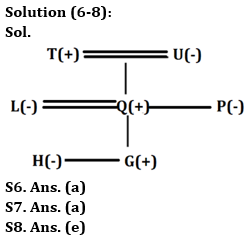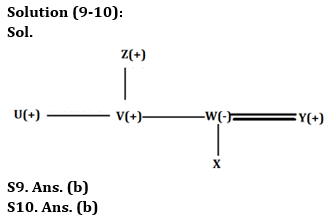Directions (1-5): Read the following arrangement of numbers, alphabets and symbols carefully and answer the questions based on it.
9 O 6 P & A 4 U S M # O 2 9 S A ? & # 2 Q 0 8 2 P @ 4 5 ! A 8 8 A $
Q1. How many vowels are immediately followed by a number in the given arrangement?
(a) One
(b) Two
(c) Three
(d) Four
(e) More than four
Q2. If all the symbols are dropped then which element will be 6th from the left end after the rearrangement?
(a) U
(b) M
(c) 4
(d) A
(e) None of these
Q3. If all the numbers are dropped then which element will be 5th from the right end after the rearrangement?
(a) @
(b) Q
(c) P
(d) !
(e) None of these
Q4. What is the sum of 5th number from the left end and 3rd number from the right end in the given arrangement?
(a) 13
(b) 7
(c) 11
(d) 14
(e) None of these
Q5. How many numbers are immediately followed by vowel and immediately preceded by letter in the given arrangement?
(a) One
(b) Two
(c) Three
(d) Four
(e) More than four
Directions (6-8): answer the questions based on the information given below.
In a family, L is married to Q. U is the mother-in-law of L. U has two children and one of them is unmarried. P is the paternal aunt of G. T is the paternal grandfather of G who is the only son of L. H is child of Q. Q is a male.
Q6. How is H related to the daughter of U?
(a) Niece
(b) Nephew
(c) Either Niece or Nephew
(d) Son
(e) Daughter
Q7. Who is sister-in-law of P?
(a) L
(b) Q
(c) U
(d) T
(e) None of these
Q8. How many female members in the family?
(a) One
(b) Two
(c) Three
(d) Either two or three
(e) None of these
Directions (9-10): answer the questions based on the information given below.
Six members are there in a family having three generations and one married couple. U is the unmarried brother of V. W is the mother of X. V is the brother of W. Y is the son in law of Z who is male. X is not married. Z has only two sons.
Q9. Who is the father of V?
(a) D
(b) Z
(c) X
(d) Y
(e) None of these
Q10. Who is the husband of W?
(a) X
(b) Y
(c) U
(d) V
(e) None of these
Direction (11-15): In the following question assuming the given statements to be true, find which of the conclusion among given conclusions is /are definitely true and then give your answers accordingly.
Q11. Statements: K ≥ C ≥ X < F = Z; X > D > Y
Conclusions: I. Z ≤ K
II. Z > Y
(a) Only I is true
(b) Only II is true
(c) Either I or II is true
(d) Neither I nor II is true
(e) Both I and II are true
Q12. Statements: P = M < O ≤ Q ≤ T = Z > I
Conclusions: I. M < Z
II. Q < Z
(a) Only I is true
(b) Only II is true
(c) Either I or II is true
(d) Neither I nor II is true
(e) Both I and II are true
Q13. Statements: D > S = I; I < Q < U; S < W = T
Conclusions: I. D > Q
II. W > U
(a) Only I is true
(b) Only II is true
(c) Either I or II is true
(d) Neither I nor II is true
(e) Both I and II are true
Q14. Statement: M > Q = U < D ≤ Z > S
Conclusion: I. D > Q
II. S > U
(a) Only I is true
(b) Only II is true
(c) Either I or II is true
(d) Neither I nor II is true
(e) Both I and II are true
Q15. Statement: D > S = Q < O ≤ T > R
Conclusions: I. S ≥ T
II. S < T
(a) Only I is true
(b) Only II is true
(c) Either I or II is true
(d) Neither I nor II is true
(e) Both I and II are true
Solutions
Solution (1-5):
S1. Ans. (d)
Sol. Given series – 9 O 6 P & A 4 U S M # O 2 9 S A ? & # 2 Q 0 8 2 P @ 4 5 ! A 8 8 A $
Hence, there are four vowels which are immediately followed by a number.
S2. Ans. (c)
Sol. After operation – 9 O 6 P A 4 U S M O 2 9 S A 2 Q 0 8 2 P 4 5 A 8 8 A
Hence, 6th from the left end – 4
S3. Ans. (a)
Sol. After operation – O P & A U S M # O S A ? & # Q P @ ! A A $
So, 5th from the right end – @
S4. Ans. (d)
Sol. 5th number from the left end = 9, 3rd number from the right end = 5,
So, required sum = 9 + 5 = 14.
S5. Ans. (a)
Sol. Given series – 9 O 6 P & A 4 U S M # O 2 9 S A ? & # 2 Q 0 8 2 P @ 4 5 ! A 8 8 A $
Hence, there is one number which is immediately followed by vowel and preceded by letter in the given arrangement.


Solution (11-14):
S11. Ans. (b)
Sol. I. Z ≤ K – False
II. Z > Y – True
S12. Ans. (a)
Sol. I. M < Z – True
II. Q < Z – False
S13. Ans. (d)
Sol. I. D > Q – False
II. W > U – False
S14. Ans. (a)
Sol. I. D > Q – True
II. S > U – False
S15. Ans. (b)
Sol. I. S ≥ T – False
II. S < T – True





 GA Capsule for SBI Clerk Mains 2025, Dow...
GA Capsule for SBI Clerk Mains 2025, Dow...
 The Hindu Review October 2022: Download ...
The Hindu Review October 2022: Download ...
 Without These Documents, Your Bank Exam ...
Without These Documents, Your Bank Exam ...





